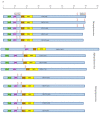Phosphorylation of Human Polyomavirus Large and Small T Antigens: An Ignored Research Field
- PMID: 38005912
- PMCID: PMC10674619
- DOI: 10.3390/v15112235
Phosphorylation of Human Polyomavirus Large and Small T Antigens: An Ignored Research Field
Abstract
Protein phosphorylation and dephosphorylation are the most common post-translational modifications mediated by protein kinases and protein phosphatases, respectively. These reversible processes can modulate the function of the target protein, such as its activity, subcellular localization, stability, and interaction with other proteins. Phosphorylation of viral proteins plays an important role in the life cycle of a virus. In this review, we highlight biological implications of the phosphorylation of the monkey polyomavirus SV40 large T and small t antigens, summarize our current knowledge of the phosphorylation of these proteins of human polyomaviruses, and conclude with gaps in the knowledge and a proposal for future research directions.
Keywords: Merkel cell polyomavirus; SV40; human polyomavirus; large T antigen; protein kinase; small t antigen.
Conflict of interest statement
The authors declare no conflict of interest.
Figures


Similar articles
-
Merkel Cell Polyomavirus Large T Antigen Unique Domain Regulates Its Own Protein Stability and Cell Growth.Viruses. 2020 Sep 18;12(9):1043. doi: 10.3390/v12091043. Viruses. 2020. PMID: 32962090 Free PMC article.
-
High-affinity Rb binding, p53 inhibition, subcellular localization, and transformation by wild-type or tumor-derived shortened Merkel cell polyomavirus large T antigens.J Virol. 2014 Mar;88(6):3144-60. doi: 10.1128/JVI.02916-13. Epub 2013 Dec 26. J Virol. 2014. PMID: 24371076 Free PMC article.
-
Regulation of Virus Replication by BK Polyomavirus Small T Antigen.J Virol. 2023 Mar 30;97(3):e0007723. doi: 10.1128/jvi.00077-23. Epub 2023 Mar 14. J Virol. 2023. PMID: 36916919 Free PMC article.
-
The role of Merkel cell polyomavirus and other human polyomaviruses in emerging hallmarks of cancer.Viruses. 2015 Apr 10;7(4):1871-901. doi: 10.3390/v7041871. Viruses. 2015. PMID: 25866902 Free PMC article. Review.
-
Merkel cell polyomavirus: a newly discovered human virus with oncogenic potential.Virology. 2013 Jan 5;435(1):118-30. doi: 10.1016/j.virol.2012.09.029. Virology. 2013. PMID: 23217622 Free PMC article. Review.
Cited by
-
Polyomavirus large T antigens: Unraveling a complex interactome.Tumour Virus Res. 2025 Jun;19:200306. doi: 10.1016/j.tvr.2024.200306. Epub 2024 Dec 13. Tumour Virus Res. 2025. PMID: 39675526 Free PMC article. Review.
-
Novel polyomavirus in the endangered garden dormouse Eliomys quercinus.Virol J. 2024 Nov 27;21(1):309. doi: 10.1186/s12985-024-02581-x. Virol J. 2024. PMID: 39605065 Free PMC article.
-
The Use of Intrinsic Disorder and Phosphorylation by Oncogenic Viral Proteins to Dysregulate the Host Cell Cycle Through Interaction with pRb.Viruses. 2025 Jun 10;17(6):835. doi: 10.3390/v17060835. Viruses. 2025. PMID: 40573426 Free PMC article. Review.
-
Merkel Cell Polyomavirus (MCPyV) and Its Possible Role in Head and Neck Cancers.Biomedicines. 2025 May 12;13(5):1180. doi: 10.3390/biomedicines13051180. Biomedicines. 2025. PMID: 40427007 Free PMC article. Review.
References
Publication types
MeSH terms
Substances
LinkOut - more resources
Full Text Sources

